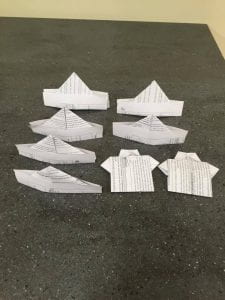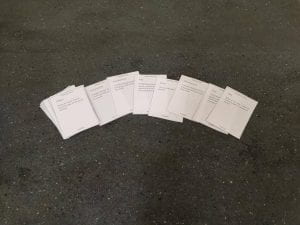Artist Statement:
The concept behind the game, Poverty, was to design an experience that allows people to effectively understand the struggle of being stuck within a poverty loop and the difficulty for one to escape that. The inspiration for this game to be created originally came from the idea of creation of art through process, which can be seen in Yoko Ono’s scores and in particular, white chess, as the meaning of the game is done through gameplay. On top of that, the concept of modifying something that exists so it becomes artwork which is similar to Marcel Duchamp’s artworks (LHOOQ, Fountain) also provided me with the inspiration to use origami as a metaphor for the labor that people in poverty have to go through. This allowed the game to successfully convey the concept of hard work as players had to quickly fold objects in order to be able to reach the end game goal. Nonetheless, it is also important to note that the feeling of hopelessness and tiresome work within Poverty came from playing the game This War of Mine which is highly noted for it’s sombre atmosphere and difficult yet simple game play, as well as the game The Cost of Life by Ayiti which is a difficult game about poverty. The mixture of multiple inspirations results in a simulation that attempts to convey the simulation of labor within families struggling in poverty, which is done through the tiring and difficult to win gameplay.
Materials:
- Paper
- Chance cards (included with the game)
- Timer
- Calculator
Rules
- Each round is 6 minutes long
- There is no maximum player count for this game. Though because of the total number of chance cards that are included (40), 1 to 4 players is ideal.
- At the end of every round, players must first take a chance card, then calculate the total amount of money made from folding items.
- Players can fold the following:
- Origami Hats (each worth $5)
- Origami Shirts (each worth $15)
- Each round players need to pay for the following:
- Water (worth $10): if the player if unable to pay for this they are disqualified
- Food (worth $20): if the player if unable to pay for this for two rounds in a row they are disqualified
- Things players can buy/invest into to progress:
- END GAME GOAL: School for the child ($150). If this is met the game is won
- School for the player ($50). This must be paid twice for the player to complete school. Payment can be separate.
- If school is completed for the player, everything folded will have a x2 value. (Origami Hats [$10], Origami Shirts [$30])
- Players are allowed to look at the samples to remind themselves how to fold the items.
Documentation:
Folded origami pieces: due to the fact that there are a lot of origami pieces folded after a single game, I have only included one set of items from one player in the photo.

Chance cards: The cards provide players with advantages as well as situations that slow down the player’s progress to reaching the end game goal.

In a total of three play tests, these things were changed: the time per round, the money that each piece folded provides the player, and what is foldable. At the start, the game was adjusted to 5 minutes per round but soon the upkeep that the player has from food and water per round made it difficult and slow for the player to progress within the game. In terms of the money that each piece folded provides, a hat originally provided the player with $5 and a shirt would give $10. However, in a play test the players just decided to make only hats since the fold count between the hat and the shirt differed drastically. Thus, I changed it so the price for a shirt would give $15 instead. Also, the game used to allow players to fold cranes. Yet, after the play tests it revealed that players do not want to fold cranes since the steps were too hard to memorize and overall it was too time consuming to fold. This made me rethink whether or not the crane was necessary to be included, which resulted in me removing it completely from the game.
If I were to place Poverty onto Schrank’s avant-garde game matrix, I would put it in an area next to the Political scale as the topic that my game discusses is extremely political and is something that connects with the everyday world directly. In a way, my game also does not allow players to really control gameplay as the chance cards and the food and water upkeep make it difficult for players to be able to progress. Because of this, I may also place it a little north of political (close of Negation) as the rules of the game dictate it heavily.
